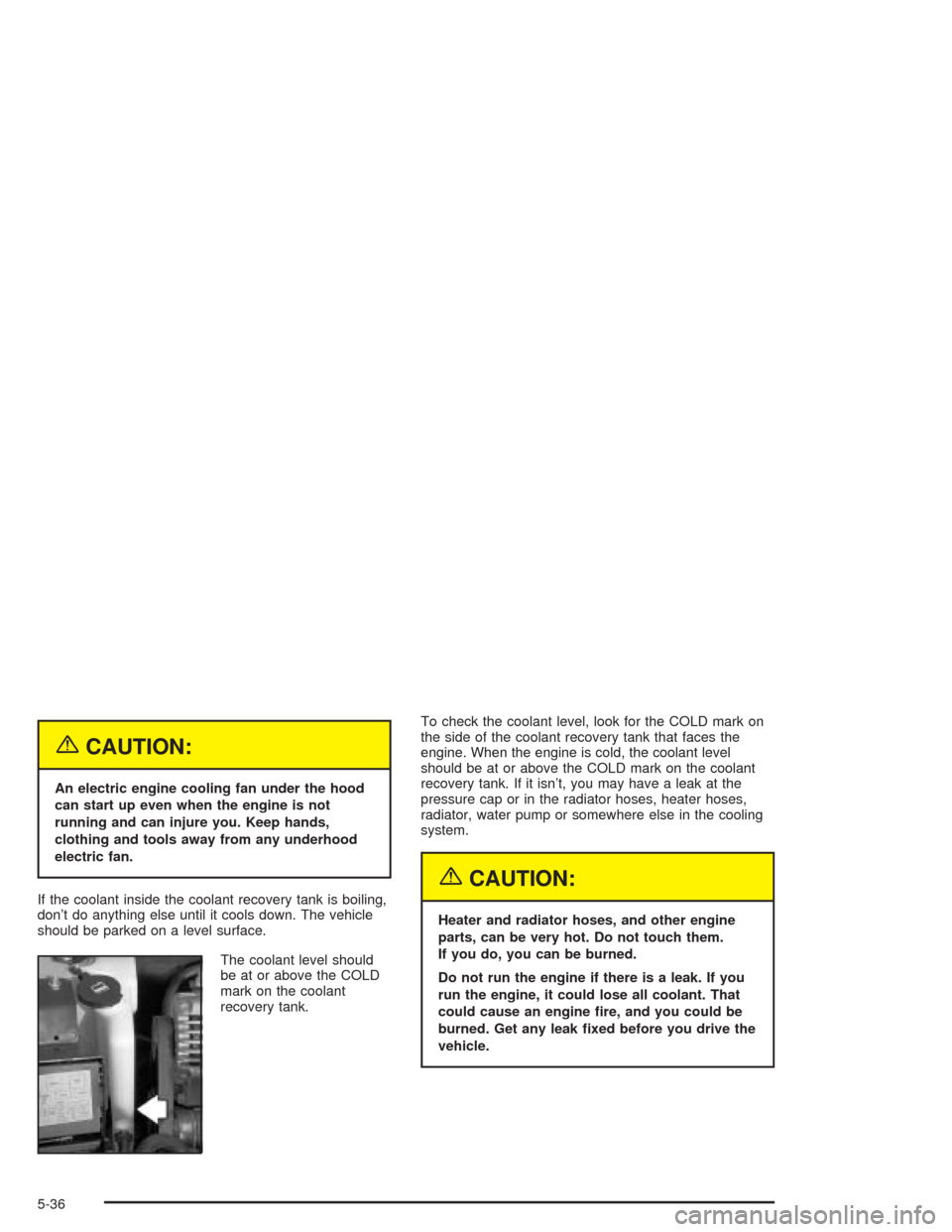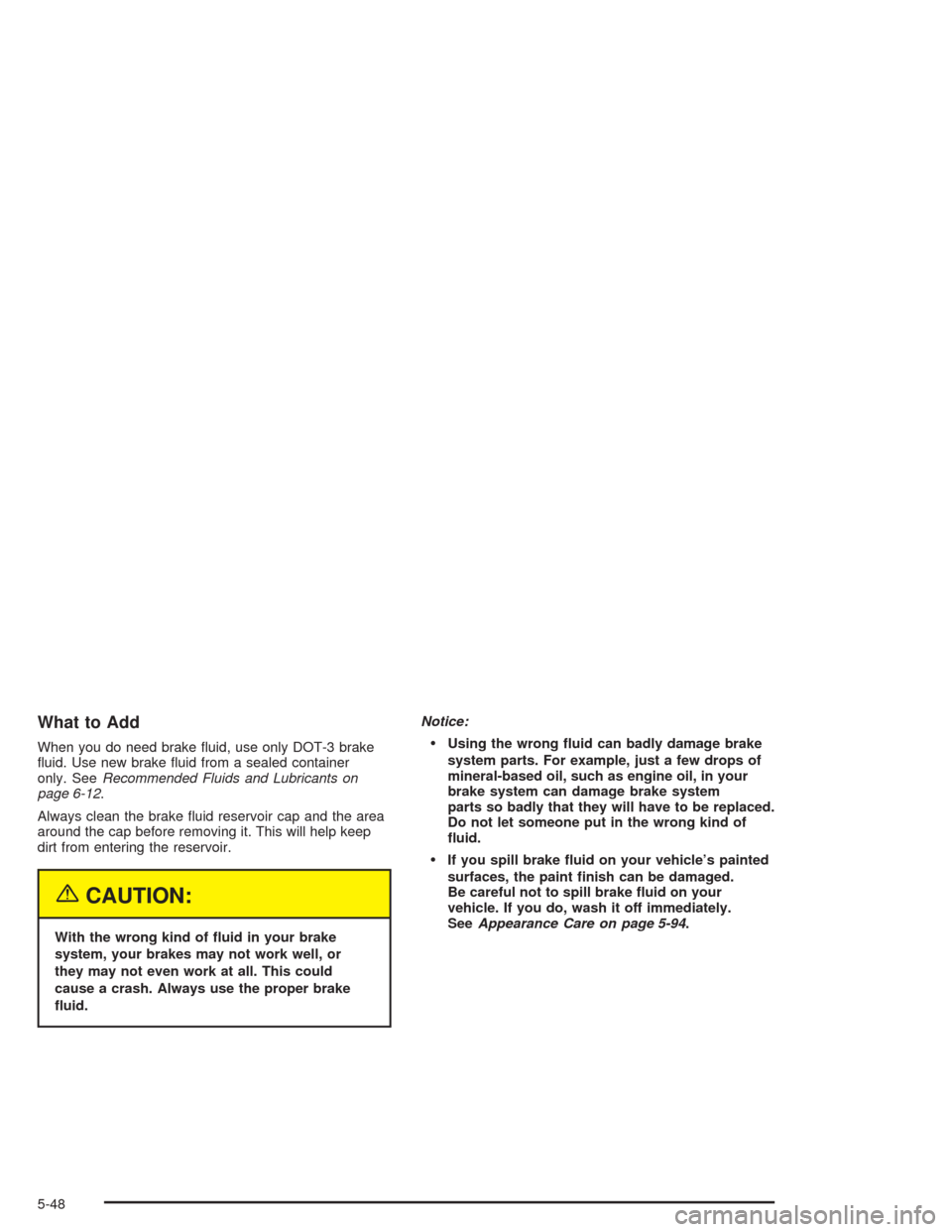Page 294 of 420

Radiator Pressure Cap
Notice:The radiator cap on your vehicle is a
pressure-type cap and must be tightly installed to
prevent coolant loss and possible engine damage
from overheating. Be sure the arrows on the cap line
up with the over�ow tube on the radiator �ller neck.
The radiator pressure cap is located in the front of the
engine compartment on the passenger’s side, near
the diagonal cross brace. SeeEngine Compartment
Overview on page 5-12for more information on location.
Engine Overheating
You will �nd a coolant temperature gage and a warning
message about a hot engine on your instrument
panel cluster. SeeEngine Coolant Temperature Gage
on page 3-36andHot Coolant Temperature Warning
Message on page 3-45.
Overheated Engine Protection
Operating Mode
This emergency operating mode allows your vehicle to
be driven to a safe place in an emergency situation.
If an overheated engine condition exists, an overheat
protection mode which alternates �ring groups of
cylinders helps prevent engine damage. In this mode,
you will notice a signi�cant loss in power and engine
performance. The low coolant light may come on
and the temperature gage will indicate an overheat
condition exists. Driving extended miles (km) and/or
towing a trailer in the overheat protection mode should
be avoided.
Notice:After driving in the overheated engine
protection operating mode, to avoid engine damage,
allow the engine to cool before attempting any
repair. The engine oil will be severely degraded.
Repair the cause of coolant loss, change the oil
and reset the oil life system. SeeEngine Oil
on page 5-18.
5-32
Page 298 of 420

{CAUTION:
An electric engine cooling fan under the hood
can start up even when the engine is not
running and can injure you. Keep hands,
clothing and tools away from any underhood
electric fan.
If the coolant inside the coolant recovery tank is boiling,
don’t do anything else until it cools down. The vehicle
should be parked on a level surface.
The coolant level should
be at or above the COLD
mark on the coolant
recovery tank.To check the coolant level, look for the COLD mark on
the side of the coolant recovery tank that faces the
engine. When the engine is cold, the coolant level
should be at or above the COLD mark on the coolant
recovery tank. If it isn’t, you may have a leak at the
pressure cap or in the radiator hoses, heater hoses,
radiator, water pump or somewhere else in the cooling
system.
{CAUTION:
Heater and radiator hoses, and other engine
parts, can be very hot. Do not touch them.
If you do, you can be burned.
Do not run the engine if there is a leak. If you
run the engine, it could lose all coolant. That
could cause an engine �re, and you could be
burned. Get any leak �xed before you drive the
vehicle.
5-36
Page 299 of 420

If there seems to be no leak, with the engine on, check
to see if the electric engine cooling fans are running.
If the engine is overheating, both fans should be
running. If they aren’t, your vehicle needs service.
Notice:Engine damage from running your engine
without coolant is not covered by your warranty. See
“Overheated Engine Protection Operating Mode”
in the Index for information on driving to a safe
place in an emergency.
Notice:Using coolant other than DEX-COOL
®may
cause premature engine, heater core or radiator
corrosion. In addition, the engine coolant may
require changing sooner, at 30,000 miles (50 000 km)
or 24 months, whichever occurs �rst. Any repairs
would not be covered by your warranty. Always use
DEX-COOL
®(silicate-free) coolant in your vehicle.
How to Add Coolant to the Coolant
Recovery Tank
If you haven’t found a problem yet, but the coolant level
isn’t at the COLD mark, add a 50/50 mixture ofclean,
drinkable waterand DEX-COOL
®engine coolant at
the coolant recovery tank. SeeEngine Coolant on
page 5-29
{CAUTION:
Adding only plain water to your cooling
system can be dangerous. Plain water, or
some other liquid such as alcohol, can boil
before the proper coolant mixture will. Your
vehicle’s coolant warning system is set for the
proper coolant mixture. With plain water or the
wrong mixture, your engine could get too hot
but you would not get the overheat warning.
Your engine could catch �re and you or others
could be burned. Use a 50/50 mixture of clean,
drinkable water and DEX-COOL
®coolant.
5-37
Page 303 of 420
{CAUTION:
You can be burned if you spill coolant on hot
engine parts. Coolant contains ethylene glycol
and it will burn if the engine parts are hot
enough. Do not spill coolant on a hot engine.
3. If you have the 3800 V6 engine, remove the
3800 Series II V6 engine cover shield to access
the bleed valve.
3.1. Clean the area around the engine oil �ll tube
and cap before removing. Twist the oil �ll
tube, with cap attached, counterclockwise
and remove it.
3.2. Lift the engine cover shield at the front, slide
the catch tab out of the engine bracket and
remove the cover shield.
3.3. Put the oil �ll tube, with cap attached, in the
valve cover oil �ll hole until you’re ready to
replace the cover shield.
5-41
Page 305 of 420
5. Fill the radiator with the proper DEX-COOL®
coolant mixture, up to the base of the �ller neck.
SeeEngine Coolant on page 5-29
If you see a stream of coolant coming from an
air bleed valve, close the valve. Otherwise,
close the valves after the radiator is �lled.
6. Rinse or wipe any spilled coolant from the engine
and the compartment.7. If you have the 3800 V6 engine, replace the
3800 Series II V6 engine cover shield.
7.1. Remove the oil �ll tube, with cap attached,
from the valve cover.
7.2. Insert the catch tab on the cover shield
under the bracket on the engine.
7.3. Place the hole in the cover shield over the
hole in the valve cover. Install oil �ll tube and
cap by twisting clockwise.
8. Then �ll the coolant recovery tank to the COLD mark.
9. Put the cap back on the coolant recovery tank,
but leave the radiator pressure cap off.
5-43
Page 310 of 420

What to Add
When you do need brake �uid, use only DOT-3 brake
�uid. Use new brake �uid from a sealed container
only. SeeRecommended Fluids and Lubricants on
page 6-12.
Always clean the brake �uid reservoir cap and the area
around the cap before removing it. This will help keep
dirt from entering the reservoir.
{CAUTION:
With the wrong kind of �uid in your brake
system, your brakes may not work well, or
they may not even work at all. This could
cause a crash. Always use the proper brake
�uid.Notice:
Using the wrong �uid can badly damage brake
system parts. For example, just a few drops of
mineral-based oil, such as engine oil, in your
brake system can damage brake system
parts so badly that they will have to be replaced.
Do not let someone put in the wrong kind of
�uid.
If you spill brake �uid on your vehicle’s painted
surfaces, the paint �nish can be damaged.
Be careful not to spill brake �uid on your
vehicle. If you do, wash it off immediately.
SeeAppearance Care on page 5-94.
5-48
Page 371 of 420
Underhood Fuse Block (Lower)
Some fuses are in a fuse block in the engine
compartment on the passenger’s side of the vehicle.
SeeEngine Compartment Overview on page 5-12
for more information on location.
Relays Usage
FAN CONT #3Secondary Cooling Fan
(Passenger’s Side)
FAN CONT #2 Cooling Fan Control Relay
Relays Usage
FAN CONT #1 Primary Cooling fan (Driver’s Side)
IGN RELAY Ignition Relay
A/C CMPR HVAC Compressor
Fuses Usage
IGN SW Ignition Switch
RT I/P #3 Rear Defogger, Audio System
U/HOOD #2 Ignition Relay, AIR Pump
COOLING
FANSCooling Fans (Battery)
FAN CONT
#2�Cooling Fan Control Relays #2 & #3
FAN CONT #1 Cooling Fan Control Relays #1
FUEL INJ Fuel Injectors
TRANS SOL Transmission Solenoids
A/C RLY
(COIL)HVAC Control Relay
ENG DEVICESCanister Purge Solenoid, Mass Air
Flow Sensor (MAF), AIR Pump
Relay & Valve Control
DFI MDL Direct Fire Ignition Module
OXY SENOxygen Sensor (Pre and Post
Converter)
5-109
Page 372 of 420
Capacities and Speci�cations
Please refer toRecommended Fluids and Lubricants on page 6-12for more information.
ApplicationCapacities
English Metric
Air Conditioning Refrigerant R-134a 2.4 lbs 1.1 kg
Automatic Transaxle
Pan Removal and Replacement
After Complete Overhaul
When draining/replacing converter, more �uid may be
needed.7.4 quarts
10 quarts7.0 L
9.5 L
Cooling System Including Reservoir
3400 (Code E) V6
3800 (Code K) V6
3800 Supercharged (Code 1) V611.3 quarts
11.7 quarts
11.7 quarts10.7 L
11.0 L
11.0 L
Engine Oil with Filter
3400 (Code E) V6
3800 (Code K) V6
3800 Supercharged (Code 1) V64.0 quarts
4.5 quarts
4.5 quarts3.8 L
4.2 L
4.2 L
Fuel Tank 17.0 gallons 64.0 L
All capacities are approximate. When adding, be sure to �ll to the approximate level, as recommended in this
manual. SeeRecommended Fluids and Lubricants on page 6-12.
5-110